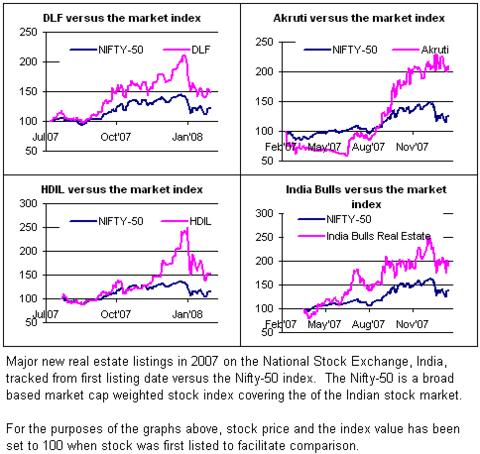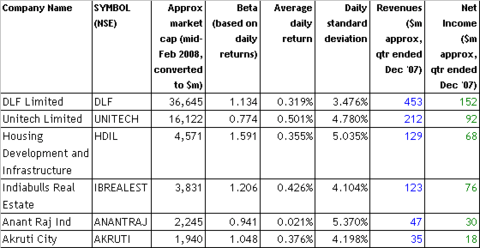As U.S housing prices come down to more sustainable levels after a prolonged boom, one can only wonder if we can expect the same story to be played out in other economies. Maybe there is some alpha waiting to be picked up. One place that stands out from a sustainability perspective is India, where real estate, whether residential or commercial, seems to have completely disconnected from local economic fundamentals.
Imagine the dusty suburbs of Bangalore, Delhi and Mumbai. Imagine neighborhoods with high rises that have no reliable power or water supply, battered roads if at all, no public transport and a shadow of crime such that locked houses aren’t safe even for a day. Now imagine these houses commanding prices that match prices in expensive New Jersey suburbs. Go figure. Or have a look here. Or if you have time, here. Perhaps there are positive returns to be had in a bet on these. But as John Paulson was quoted in the WSJ , “you can’t short houses”. But maybe we can short some of the companies that build and sell these houses.
The Indian equity markets have enjoyed a tremendous bull run over the past few years. In 2007, the Indian markets were up 47%. Real estate was up even more on a frenzy that makes New York and London decidedly tame. Seeing the time to cash in, multiple ‘mega-issues’ or IPOs from real estate developers came out in 2007. Exorbitantly priced to begin with, they did not disappoint their investors. These IPO stocks outperformed the index (the one that was up by 47%!) by a handsome margin. We look at how some of the larger public offerings have done since they were listed. Terrific!
Which brings us to the point of this post. How sustainable are half a million dollar apartments in a country with an average wage of about $1000 (a year)? Sure there are rich people in poor countries. Maybe enough to keep things going merrily forever. But maybe not.
Most people do believe that this is a bubble that is bound to burst. Perhaps it is only a question of when, and not if. But as said Keynes – the market can stay irrational for longer than you can stay solvent. There is no shortage of alpha seekers (and of academics and economists ridiculed on television) that were hurt calling a false top to the real estate market in the US. The same can happen anywhere, but given the fizz going out of the global markets, the Indian bubble may probably be short lived too.
Sourcing alpha
One bet may be to short some or a diversified portfolio of these real estate companies. The Indian markets have already seen a correction in 2008, and that may or may not continue. These stocks do contain significant beta, so to guard against the risk of the general market going up, perhaps a market neutral short position in some of these companies may be desirable. As is the nature of the game, many of these companies have not been listed for too long, so betas that I calculated in the table below are probably unreliable but perhaps not a bad starting point for making an estimate for the future.
Here are some tickers (on nseindia.com, or add .ns after the ticker for Yahoo Finance) with some data. All information is approximate, US dollar conversions have been done using a single rate of Indian Rupees 40 = USD 1. Notice the volatility in the stocks, they go up and down fast for sure. Also look at their fantastic profit margins. Who cares about EBITDA when net income to revenue ratios are straight out of wonderland!
click to enlarge
Profiting from the strategy
For investors in the US, it is not easy to gain non-systematic exposure to a particular company or sector in India. There are a few funds such as The India Fund (IFN), Morgan Stanely India Investment Fund (IIF), iPath MSCI India (INP) and more recently, WisdomTree India (EPI), that provide broad based exposure to the Indian market, but nothing that would specifically target a particular stock or a sector.
However, there are a number of Indian stocks that are listed either on the NASDAQ or the NYSE as ADRs. Many of them are also included in the broader Indian S&P Nifty-50 market index (referred to above). These include the following:
List of Indian stocks listed in the US that are also a part of the S&P Nifty-50 market index:
- Dr Reddy's Labs (RDY)
- HDFC Bank (HDB)
- ICICI Bank (IBN)
- Infosys (INFY)
- Satyam (SAY)
- Satyam Technologies (SIFY)
- Sterlite (SLT)
- Tata Communications (TCL)
- Tata Motors (TTM)
- Wipro Ltd (WIT)
The list above covers industry, banking, communications and technology, but does not include any exposure to the real estate sector - except probably with the exception of HDB and IBN that have mortgage lending operations in India.
This opens up an interesting possibility - consider building a synthetic portfolio where one goes short on the entire market using IFN, IIF or INP and simultaneously going long on a portfolio of individual stocks listed above in a way that the net exposure is only to real estate or related stocks. Unfortunately, real estate stocks currently comprise only about 4% of the Indian stock market capitalization, and as of the date of this post only Unitech is part of the Nifty-50. That makes this strategy a bit tricky to achieve but in the coming days, as DLF and other Indian companies get included in the Nifty-50, it would be possible to create a portfolio that is strongly correlated (positively or negatively) to the Indian real estate sector.
If someone has any ideas or suggestions on how this strategy could be refined to target the desired exposure, do send me your comments.



No comments:
Post a Comment